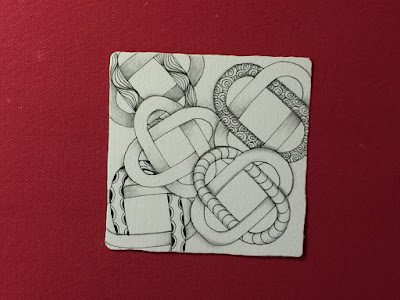Of course I immediately knew what was going to happen with the elephant collage that had stumbled out of my scrap box. And I've started it off. It is still very much a work in progress.
And that wily elephant got me thinking. And there is lots of time to think when you are sorting everything from paper to corks! One bite at a time is the answer to so many things.
I thought of it when a friend asked how to get started in lettering. I've been at lettering for a very long time. And I learned it one bite at a time. The problem I have said many times is that people want to take an afternoon class and know how to letter. That is just one small bite and calligraphy is a very large elephant. Actually it is a large herd of elephants. But that is a good thing. You start with one style of lettering and you digest it slowly, lots of leftovers and such. And then you discover a new style and you take a bit of that. It is a whole buffet and there are so many options. It takes years. It fills your life with possibilities and you learn discipline through practice and you make wonderful new friends who become treasured old friends. It isn't just a fast food meal. It is slow food.
I thought about it when I was remembering the amazing meal my friend Chris Titus cooked for a small group of us on Labour Day weekend. She had planned and created and cooked for weeks. The meal was heavenly - so many perfect bites. We were so grateful for the experience but I know that Chris got a thrill from planning those bites and working through the process. I also know she wore herself out because managing an elephant is tiring, rewarding but tiring. What I know for sure is that if I ever had to eat elephant for real (and that is a truly disgusting thought) I'd call her. I know she could find a way to sous vide it. She has a pot for everything! It would taste amazing. It would be served on just the right plate with the perfect wine. There would be sauce.
And then I was thinking about my friend Nancy who is the quintessential organizer. She is an active volunteer who sees a need and finds a way to fill it. One of the organizations that benefits from her energy is the Grandmothers to Grandmothers Campaign (https://stephenlewisfoundation.org/get-involved/grandmothers-campaign). Her local chapter in Brampton finds many creative ways to earn money to support AIDS work in Africa (yes, this is still a major problem) but one of my favourites is their soup luncheon where you take 5 books to trade for 5 new books and share a lunch of homemade soups. (It is coming up if you are local and interested!) They are literally serving up the 'elephant' one bite at a time, finding a practical way to support grandmothers in Africa who are raising the children who have lost their parents to AIDS.
So I will continue to try and be cheery as I head into the studio, taking my daily bite of the elephant. I know that when it is tamed the sewing room awaits. And then the office. By the time I get moved I am going to be really sick of elephant.
And my collage that is WIP will get gloriously tangled. I've already started roughing in some ideas in pencil. Zentangle is another thing that is one bite at a time although we say it is "one stroke at a time". You don't worry about how long it will take or where it will take you. You just take the cap off your pen and make the first stroke. I'll let you know when it is done. It may be a while.







































